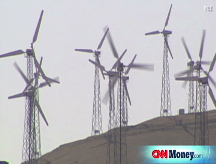Oil settles near $48 on auto vote
Passage of the $14 billion measure to aid carmakers helps boost sentiment about economy, but threatens weaker dollar.
NEW YORK (CNNMoney.com) -- Oil prices jumped Thursday after the House passed a $14 billion stop-gap measure designed to keep the U.S. auto industry from immediate collapse.
U.S. crude for January delivery rose $4.46 to settle at $47.98 a barrel in New York. It rose to a high of $49 a barrel earlier in the session.
The House passed a bill that would provide $14 billion in loans to automakers General Motors (GM, Fortune 500) and Chrysler, and keep them out of bankruptcy until at least March. Ford Motor (F, Fortune 500), which is in better shape cash-wise than its counterparts, is not part of the $14 billion plan.
The measure, which still faces a vote in the Senate, could prevent a large blow to the economy of the world's largest oil consumer.
An auto bailout has been largely priced in to oil, but a collapse of the U.S. auto industry "would result in a very painful [price] correction, not only in crude oil, but also in the equity markets," said Chris Lafakis, associate economist with Moody's Economy.com.
The U.S. auto industry employs about 2 million workers, according to the Center for Automotive Research. That total includes GM (GM, Fortune 500), Ford (F, Fortune 500) and Chrysler workers, as well as dealers and workers at parts manufacturers.
In urging Congress to pass the auto bailout, the White House cited jobless claims, which jumped to a 26-year high last week, according to the Labor Department.
Falling dollar: Oil prices also got a boost Thursday as the value of the U.S. dollar fell versus other major currencies.
The dollar slipped against the 15-nation euro, British pound and Japanese yen.
"We're seeing concerns that all these bailouts are going to lead to more interest rate cuts and a weaker dollar," said Phil Flynn, senior market analyst with Alaron Trading in Chicago.
A weaker dollar makes oil (which, like other commodities, is demoninated in dollars) cheaper for foreign investors, which spurs buying.
OPEC cut: Investors are also looking for a large cut in production from the Organization of Petroleum Exporting Countries, an international trade cartel whose members produce about 40% of the world's oil, when it meets next week in Algeria.
Due to falling worldwide demand, crude prices have plummeted more than $100 a barrel since hitting a record high of $147.27 in mid-July.
The deep cut in prices has raised serious concerns for many OPEC members who rely on oil profits to fuel their domestic economies.
Earlier this week, OPEC President Chakib Khelil told the Associated Press that the oil market could expect to see a "severe" cut in production levels.
Some analysts believe the group could cut production by as much as 3 million barrels a day in order to bolster prices.
A production cut is "almost inevitable," said Paul Horsnell, head of commodities research with Barclays Capital.
However, a large OPEC cut will play a mostly psychological role, according to Horsnell.
"Actually, there's been a lot of oil that's come off [the market]," said Horsnell, who pointed out cuts from OPEC and non-OPEC producers. But the market's perception is that there's a very large hole to be filled, he added.
The organization agreed to cut 1.5 million barrels a day at the end of October, but there has been talk that some members were not cutting as much as they had pledged.
In November, OPEC pumped about 28.16 million barrels a day, not including Indonesia, which leaves the group at the end of the year, and Iraq, according to estimates from research firm Platts. That is a decline of only 950,000 barrels a day from October.
Some of those worries were allayed however, after Saudi Arabia, the world's largest oil producer, said that it had come very close to its OPEC production target last month, according to reports.
"It gives them a little more credibility going into that Wednesday meeting," said Lafakis.
Falling demand: Global demand for crude oil will shrink this year for the first time since 1983, according to the International Energy Agency, which advises the energy policies of 28 oil importing nations.
The Paris-based group said Thursday that any turnaround in demand next year will depend on some sort of economic recovery.
Just such a turnaround was predicted by billionaire hedge fund manager T. Boone Pickens, who is heavily invested in wind power. Oil could go back up above $100 a barrel next year, he said in a television interview. ![]()




